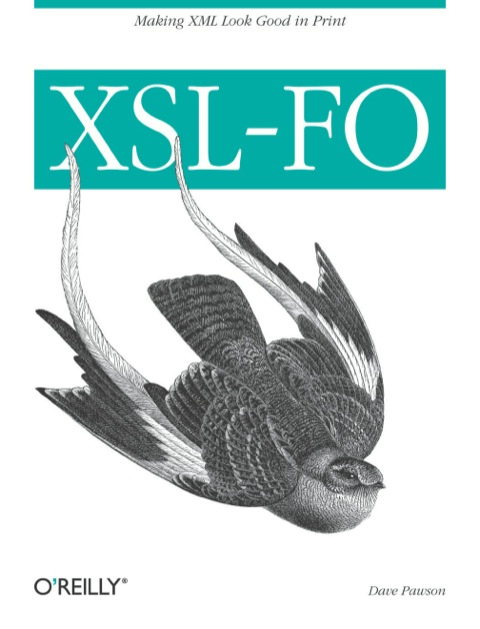XSL FO 1st Edition by Dave Pawson 9780596516956 0596516959
$50.00 Original price was: $50.00.$35.00Current price is: $35.00.
XSL FO 1st Edition by Dave Pawson – Ebook PDF Instant Download/Delivery: 9780596516956, 0596516959
Full download XSL FO 1st Edition after payment

Product details:
ISBN 10: 0596516959
ISBN 13: 9780596516956
Author: Dave Pawson
No matter how flexible and convenient digital information has become, we haven’t done away with the need to see information in print. Extensible Style Language-Formatting Objects, or XSL-FO, is a set of tools developers and web designers use to describe page printouts of their XML (including XHTML) documents. If you need to produce high quality printed material from your XML documents, then XSL-FO provides the bridge.XSL-FO is one of the few books to go beyond a basic introduction to the technology. While many books touch on XSL-FO in their treatment of XSLT, this book offers in-depth coverage of XSL-FO’s features and strengths. Author Dave Pawson is well known in the XSLT and XSL-FO communities, and maintains the XSLT FAQ. An online version of this book has helped many developers master this technology. XSL-FO is the first time this reference is available in print.The first part of the book provides an overview of the technology and introduces the XSL-FO vocabulary. The author discusses how to choose among today’s implementations, explains how to describe pages, and shows you what is going on in the processor in terms of layout. You’ll learn about the basics of formatting and layout as well as readability.The second part focuses on smaller pieces: blocks, inline structures, graphics, color and character level formatting, concluding by showing how to integrate these parts into a coherent whole. XSL-FO also explores organizational aspects you’ll need to consider?how to design your stylesheets strategically rather than letting them evolve on their own.XSL-FO is more than just a guide to the technology; the book teaches you how to think about the formatting of your documents and guides you through the questions you’ll need to ask to ensure that your printed documents meet the same high standards as your computer-generated content. Written for experienced XML developers and web designers, no other book contains as much useful information on this practical technology.
XSL FO 1st Table of contents:
- Preface
- Who Should Read This Book?
- What Does This Book Cover?
- Motivation
- Organization of This Book
- What Else Do You Need?
- Conventions Used in This Book
- How to Contact Us
- Acknowledgments
- Planning for XSL-FO
- XML and Document Processing
- Choosing Your Print Production Approach
- Why XSL-FO?
- Alternatives
- Choosing Tools
- Selection Criteria
- Price
- Compliance
- Usage
- Platform and Performance
- The Future for XSL-FO
- A First Look at XSL-FO
- An XSL-FO Overview
- Related Stylesheet Specifications
- XSL and DSSSL
- XSL and CSS
- Using XSL-FO as Part of XSL
- History
- Page Layout, Blocks, and Inline Content
- Considering Compliance Levels
- Selecting Content for Formatting
- Matching Source to Content
- Shorthand, Short Form, and Inheritance
- Inheritance
- Tips on Using Inheritance
- Layout-Driven and Content-Driven Layout Types
- Pagination
- Document Classes
- The Main Parts of an XSL-FO Document
- Simple Page Master
- Margin Properties for Blocks
- Regions
- Absolute and Relative Directions
- Writing Mode
- Content Flows
- A Basic Example
- Complex Pagination
- Single-page-masters
- Constructing Runs of Identical Pages
- Conditional Selection of Page Masters
- Page Conditions
- Page Sequences
- Page Numbering
- Country and Language
- Areas
- Informal Definition of an Area
- Area Types
- Components of an Area
- Reference Areas
- Area Positioning
- Turning Formatting Objects into Areas
- Area Dimensions
- Positioning a Block-Area: Margins and Indents
- Stacking Block-Areas and Spaces
- Stacking Inline-Areas
- Stacking Line-Areas
- Blocks
- Block Basics
- The Basic Block
- Block Separation
- Breaks Between Paragraphs
- The Block as a Wrapper
- Blocks for Special Purposes
- Backgrounds on Blocks
- Images
- Identifying Blocks
- Decorating Blocks
- Lists
- Other Types of Lists
- Alignment Issues
- Tables
- The Basic Table
- Captions
- Column Headings
- Fixed-Width Tables and Columns
- Fixed columns
- Spanning Columns and Rows
- Empty Cells in Tables
- Cell Alignment
- Other Table Issues
- Additional Material
- A Minor Aside on Lengths
- Short forms
- Inline Elements
- Content
- Inline Styling
- Inapplicable Properties
- Inline Containers
- Inline Graphics
- Word and Letter Spacing
- Other Styling Properties
- The Horizontal Rule and Its Variants
- Line Layout
- Keeping Line Content Together
- Other Uses
- Page Headers
- Graphics and Color
- Graphics
- Basic Color Usage
- Color Specification
- Color Profiles
- Applicability
- Summary
- Styling at the Character Level
- General Character Properties
- Usage
- Writing Mode
- Superscript and Subscript
- Fonts
- Shorthand Attribute Specification
- Cross-Document Links
- Cross-Document Links
- Page Numbering
- Indexing and Tables of Contents
- Running Headers
- Footnotes
- Putting It All Together
- Outline
- Page Layout
- The Template File
- Property Sets
- Stylesheet Organization
- Classes of Stylesheets
- Specialized Stylesheets
- General-Purpose Stylesheet
- Local Modifications
- Overall Stylesheet Organization
- Page Layout
- Main Flows
- Inclusion and Importing
- How Do I Do That?
- Finding Your Way Around the Specification
- Overview
- index.html
- Section 1
- Section 2
- Section 3
- Section 4
- Section 5
- Section 6
- Section 7
- Section 8
- Appendix A
- Appendix B
- Appendix C
- Appendix D
- Appendix E
- Appendix F
- Appendix G
- Today’s Tools
- RenderX XEP Formatter
- Antenna House Formatter
- FOP Formatter
- PassiveTEX Formatter
- Unicorn Formatting Objects Formatter
- Formatting Objects Authoring Tool
- Render Engine from XML/XSL to PDF
- jfor, Java XSL-FO to RTF converter
- XMLmind FO Converter
- XSLfast
- Epic Editor V4.2
- IBM XSL Formatting Objects Composer (XFC)
- Summary
- Objects, Properties, and Compliance Levels
- Basic, Extended or Complete?
- Property Summary
- Inheritance Characteristics
- Font-, Character-, and Spacing-Related Properties
- Visibility-Related Properties
- Writing Mode–Related Properties
- Border- and Text Decoration–Related Properties
- Whitespace- and Line Break–Related Properties
- Leader- and Rule-Related Properties
- Indent-Related Properties
- Border-Related Properties
- Caption-Related Properties
- Color-Related Properties
- Alignment-Related Properties
- Table-Related Properties
- Keeps- and Breaks-Related Properties
- List-Related Properties
- Language-Related Properties
- Examples for Chap ter 10
- Elements and Valid Properties
- XSL-FO Elements and Their Properties
- Properties and the Elements to Which They Apply
- GNU Free Documentation License (GFDL)
- Preamble
- Applicability and Definitions
- Verbatim Copying
- Copying in Quantity
- Modifications
- Combining Documents
- Collections of Documents
- Aggregation with Independent Works
- Translation
- Termination
- Future Revisions of This License
- Addendum: How to Use This License for Your Documents
- Glossary
- Index
People also search for XSL FO 1st:
xsl 1.1
xsl for beginners
xsl 1.0
xsl format
c.s. lewis first edition books
Tags:
XSL FO,Dave Pawson



